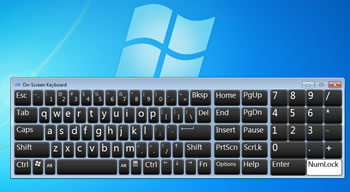The Dell Inspiron mini, maddeningly, does not include a numeric keypad. This is what you need to enter so-called Alt-codes to produce special characters (e.g., ê, —, “). The workaround you see most often is to use the Character Map and copy-and-paste. Frankly, that sucks.
You might also add an external keypad, but as one commenter online said, that defeats the effing purpose of having a netbook (emphasis added, all caps removed).
 I started looking around for a virtual keyboard, after seeing one in action at Google Translate. Well, it turns out Windows has had on “on-screen keyboard” for several iterations of Windows as part of its suite of accessibility tools. It’s called osk.exe, and I made a shortcut to it in my taskbar.
I started looking around for a virtual keyboard, after seeing one in action at Google Translate. Well, it turns out Windows has had on “on-screen keyboard” for several iterations of Windows as part of its suite of accessibility tools. It’s called osk.exe, and I made a shortcut to it in my taskbar.
Don’t think the trail ends here, though. There’s no way to hold down the Alt key on the virtual keyboard, so there’s no way to enter the multidigit code. I discovered that you can hold down Alt on the physical keyboard, but that in combination with the virtual numeric keypad didn’t work.
Back to searching …
Someone online had suggested the Alt-Fn combination with the regular number row, which didn’t work (surprise). But, what the heck, I thought I’d cobble that combination with the physical/virtual combo above (Alt on one, numbers on the other), and—I’ll be damned!—it worked. (See them dashes? I mean, see the em-dashes? Made on the Inspiron mini without the use of Character Map or any copying/pasting.) You have to press Alt first, then Fn (holding them both down), before hitting the numbers (i.e., Fn then Alt doesn’t work).
I’m still pissed off at Dell for not including the numeric keypad on the Inspiron mini. But I can now, finally, relegate that animus to a deeper part of my psyche.

